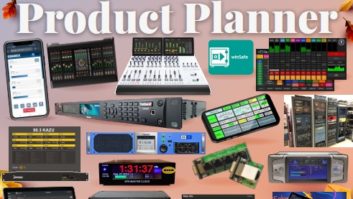Though we write often in Radio World about overarching trends and benefits of routing infrastructure systems, here we invited several companies that build such systems to get really specific and tell us about one interesting, new or unique product — or even a specific feature or capability — that has helped or could help solve an interesting problem.
High Density, Small Space
“This is a small-scale item but has proven useful for many customers,” says John Davis, technical support manager for Logitek.

Logitek JetStream Mini “Logitek’s JetStream Mini router packs the I/O needed for a studio operation into just two rack units. Because it uses fanless cooling, it can reside in an air studio along with the other equipment. This is a space-saving way to manage individual studios in facilities that want the advantages of assignable inputs and other router-based functions at a console, even if they don’t want to network their studios together.”
Davis said the company achieves high density in a small space in three ways.
“JetStream is a hybrid of TDM and AoIP, so where possible we keep the audio within the same router frame and do not need to send it off to an external box to get mixed. That means that you only network the signals that need to leave the frame and everything is processed with the lowest latency possible,” he said.
“Second, we employ system-on-chip technologies for AoIP to encode and decode up to 160 channels of audio, depending upon the size of the JetStream frame. Third, by aggressively using multiple low-voltage power supplies within the JetStream, we have an efficient device that consumes fewer watts than our older products, generates less heat and is easier to keep cool.”
Info:www.logitekaudio.com
Customizing AoIP Without All the Programming
“For all that IP audio networking has done to make our lives easier, a lack of management tools has made it largely inaccessible to the typical broadcaster,” says Wheatstone’s Jay Tyler.

Wheatstone Screen Builder “Putting the control and flexibility of AoIP directly into the hands of broadcasters is the thinking behind our new Screen Builder app,” Tyler said. “Screen Builder lets broadcasters do all those things with their WheatNet-IP audio networks that were only possible by programmer types before.”
With this custom application, you could, for example, create a screen so your show producer could IFB to the host by tapping on a headphone icon. You could create dedicated screens that let him turn microphones on or off, monitor program sources or mix feeds. This is all done through a touchscreen app that gives broadcasters access to any aspect of the WheatNet-IP environment.
“Broadcasters simply drag, drop and assign attributes to faders, meters, labels, buttons, clocks, timers and other widgets that they can arrange on a PC screen and program to fire salvos, switch between crosspoints, turn equipment on or off, and more,” said Tyler. “It’s all completely scriptable using WheatNet-IP’s Script Wizard.”
Info:www.wheatstone.com

The Cat-6 “Everything Wall” at KYW(AM)’s new plant in Philadelphia.Make It Twisted Pair
“In the broadcast engineer’s world, ‘convergence’ is code for ‘now we do IT,’” said Dan Braverman, president of Radio Systems Inc. “So most engineers and manufacturers I know now spend much of their time writing code, configuring networks and browsing links, simultaneously doubling our capabilities and workloads.
“But from an infrastructure standpoint (code for wiring) the situation has gotten easier, not harder,” he continued.
“That’s because Cat-6 twisted pair and the gear, companies and installers that support it now provide one universal, cheap and 100 percent compatible way to wire it all together. Cat-6 (and Cat-5) supports all your signals: analog, digital, VoIP and Ethernet. There just really is no need or reason to ever install shielded audio cable again.”
Braverman says this is important for several reasons. “No plant is static in todays’ market. Cables pulled for legacy analog lines today could be tasked to run an IP Ethernet links tomorrow. Cat-6 can do it all. Run twisted pair everywhere. Run a lot of it and use it exclusively. You will future-proof your work. And when a new facility is put together, there is always a local ‘low-voltage’ wiring contractor hired to provide low-cost, dependable, high-speed Cat-5 runs and switches for what used to be just for your enterprise phones and PCs. Double their contract and let them pull some of these same lines from the studios to TOC. It will be the best (and least) money you’ll spend on your new facility.
“Every major console manufacturer now sports RJ-45s to connect directly to the Cat-6 infrastructure. And companies like Radio Systems make a myriad of adapters to connect to gear that still doesn’t support this topography natively. But whether you buy it pre-made or roll your own, make it twisted pair. It the only way to go.”
Info: www.radiosystems.com
Integrating Consoles/Automation, Cobranet and Software
When you have more than one on-air studio, you quickly recognize how important it is to plan your wiring, says Ben Palmer of Arrakis Systems.

Cobranet products from AudioScience are at the core of Arrakis AARC-NET. “If you’re in the situation of updating your old consoles, and find the rat’s nest of cables from your old setup, or if you are starting brand new and want it done right the first time, then using a network is the way to go.”
Arrakis Systems offers AARC-NET. “This is a seamless integration of Arrakis consoles and automation, Cobranet audio networking products and Arrakis software,” Palmer said.
“One of the benefits of Cobranet is that it is a common network technology, with over 1 million nodes installed. Therefore, all Cobranet products from different manufacturers work together to form a powerful audio network.”
He said the core of the AARC-NET network are Cobranet products from AudioScience, which are plug-in compatible with the Arrakis ARC, MARC and X-Mixer consoles, so that installation and setup take minutes.
“No more punchblocks or multipair cables. Changing a wiring connection is a simple software choice. This makes AARC-NET is fast, easy and inexpensive,” he said.
Palmer said a notable feature of AARC-NET is that it integrates standard analog and digital consoles onto the network instead of using expensive network-based digital mix engines. “You can therefore integrate consoles that you already own into the system. This makes repair and maintenance easy, and your console doesn’t fail when the network crashes. Most importantly, AARC-NET is world standard Cobranet, not a custom one-of-a-kind network.”
He said the cost of a standard AARC-NET system is a third to half that of competing systems.
Intelligent Edge Devices, Increased Connectivity
GatesAir continues to emphasize the value proposition of distributed studio architectures over the classic consolidated system, where one massive, centralized box routes audio and data facility-wide.

GatesAir VMConnect “Through GatesAir’s Flexiva routing tools like the VMConnect audio management frame and VMQuadra automation and computer interface, the company is simplifying routing infrastructure by bringing these compact systems closer, and even into, on-air and production studios,” said Joseph Marshall, product line manager for GatesAir.
“As a result, these intelligent edge devices help broadcasters establish the shortest physical path for connecting sources and destinations, while increasing local I/O capacity and network connectivity.”
The networkable console is one of these important connected sources of distributed routing architecture. GatesAir offers its RMXengine device to add more networking flexibility for customers of its large-format RMXdigital consoles.
“Essentially, the RMXengine enables advanced dual-console operation for dual-anchor studio operations in networked systems, and provides flexible options for mix-minus and IFB talkback channel,” Marshall said.
“Between our Flexiva VM Series tools and RMXengine, we’re looking to not only maximize flexibility in routing and on-air infrastructure, but also add scalability across the board.”
He pointed to the RMXengine as particularly useful because broadcasters can scale the solution to meet their needs in a variety of ways.
“For example, a prominent customer of ours in New York City recently had a very unique need to join two consoles for dual-operator use during one daypart. RMXengine addressed this need by networking two consoles into a common operation, while delivering the added bonus of enabling mix-minus on every fader.” Other customers, he said, might start with mix-minus capability on two faders, and assign that capability to additional faders as requirements change.
“We believe this kind of flexibility and scalability applies to broadcasters of any size, in any market.”
Info: www.gatesair.com
Console Remote Control Gives You “Virtual Faders”
“Many modern AoIP consoles have remote-control applications that allow broadcasters to use a PC or tablet to operate the board from a different location, as if they were sitting right in front of it,” said Clark Novak of Axia Audio.

Axia SoftSurface “With these apps, talent can change sources, start audio, tweak EQ, take calls, trim faders and more, just as if you were there. Axia Audio’s SoftSurface software for Windows has this sort of rich toolset, and naturally, talent in the field love it.”
However, he said, there are some less well-known SoftSurface abilities that allow operators in the studio to get even more from their consoles.
“For instance, Axia Element and Fusion consoles can have up to 40 physical faders. But Axia mixing engines enough horsepower to support up to 48 faders. Using SoftSurface, these ‘virtual faders’ can be controlled directly, allowing talent access to more ‘faders’ than their console actually has.”
He said broadcasters have found this ability especially useful in live interview and “roundtable” settings, when there may be more mics needed than console faders.
“It’s also handy for giving moderators in a discussion studio the ability to directly control guest mics from a compact, portable tablet, or allowing on-the-fly mixing of in-studio live musical performances.”
Novak said that when used with multi-touch touchscreen tablets, these abilities are even more enhanced, with talent able to adjust groups of faders simultaneously. “And SoftSurface can connect to any Element or Fusion console in the facility.”












